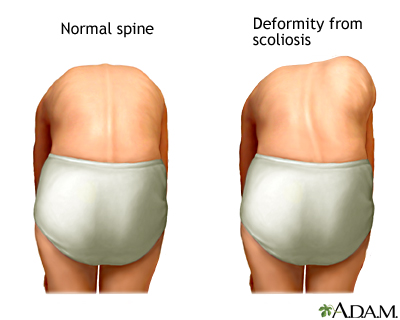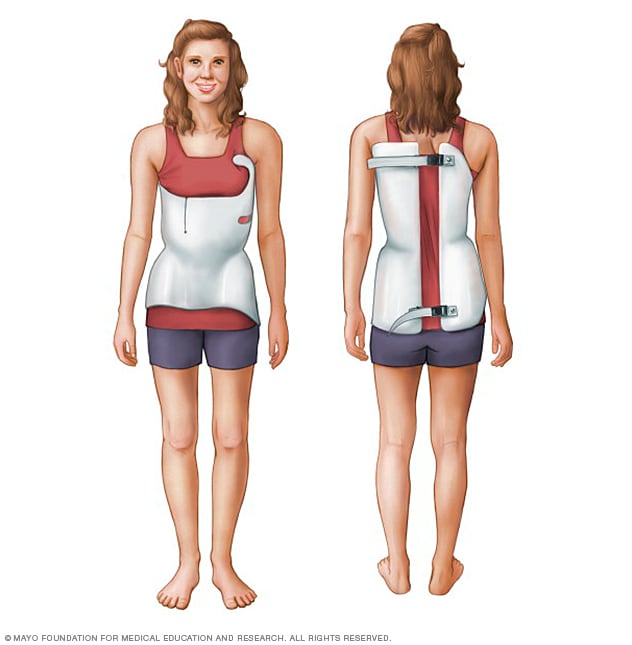Young Nigerians Living with Scoliosis
YOUNG NIGERIANS LIVING WITH SCOLIOSIS
Thursday has never been my favourite day, and on this particular day, it cemented itself as the least favourite day of my life. Every health issue I have was discovered on a Thursday, major and minor injuries/surgery happens on this day. Sporting exercise had just ended that day, and I was privileged not to participate that week because I was a senior. As I walked up the stairs to my class, my least favourite teacher asked to see me.
She took me to the basketball court and quizzed me about my recurrent back pain. Before then, I had complained to my mum who thought this was as a result of carrying heavy backpacks. She gave me a note which occasioned me visiting the hospital, where I was diagnosed using the Adams forward bending test and series of x-rays.
The doctor told me that day “you have scoliosis with a 30-degree curvature, you're so lucky”
Scoliosis is an abnormal curvature in the spine; it occurs during the growth spurt just before puberty. The typical shape of a person’s spine includes a curve at the lower back. A scoliosis spine is curved from side to side often giving it either a C shape or S shape. The normal curve of the spine allows the head to balance directly over the pelvis. If one or more of these curves is either too small or too high, the head is not correctly balanced, leading to back pain, stiffness and an altered walking pattern. It would do you some good to know that most athletes and celebrities are also scoliosis patients. The likes of Olympian, Janet Evans and Usain Bolt, tennis star James Blake, and the list continues.
For some people living with scoliosis, constant back pain isn't an issue but for 23% of patients with idiopathic scoliosis, they present back pain at initial diagnosis. As if having a bent spine isn't enough, dealing with pain where using pain killers isn't recommended could be unbearable.
Living with scoliosis is a rollercoaster of good and bad days, it involves daily stretches, yoga, sleeping on your back or side and being careful as simple everyday tasks like tying shoelaces, lifting heavy shopping bags, Sitting/standing for long hours could result in discomfort. For Daniel, waking up to a weak back and numb legs could hinder productivity at work but he never lets his condition limit him. He gets to work earlier than every other worker and has never taken a day off because of his condition.
Nigeria records about 1.5million cases of scoliosis yearly across states. A higher percentage of this spine deformity happens to females and lesser cases for male. About 80% of scoliosis cases are idiopathic—a term used to refer to cases that have no definite cause. Neuromuscular scoliosis is the second most common form of scoliosis and is associated with disorders of the nerve and muscular systems such as Cerebral palsy, spina bifida and spinal cord injury. Degenerative scoliosis occurs mostly in adults. It is caused mainly by changes in the spine caused by arthritis. The weakening of the healthy ligaments, soft tissues combined with some abnormal bone spurs which lead to an abnormal curvature of the spine.
HOW TO DETECT SCOLIOSIS IN A CHILD.
For Ayo, she was having her bath when she was 10 years old. Bending over to scoop water on my body, there and then, her mum noticed the huge difference in her spine. Early detection is crucial to treating scoliosis, delay in detection can lead to an increase in curvature which can worsen into lung and heart conditions. To detect scoliosis early, the Adams Forward Bending Test should be used. Symptoms such as uneven shoulders, unleveled hips, the head that doesn't align with the pelvic and rib cage can be detected through this process. Funmi shared her story saying “For someone who is very insecure about her body, I was asked to strip in front of a male doctor with only my bra on. The doctor wanted to examine my back. A part of my shoulder bulged out, I could see it from the mirror. It was at this point I knew something was wrong”. After this test, if done at home, visiting the doctor is the next thing.
Doctors often ask their patients to do an x-ray which they use in measuring the degree of curvature. This measurement helps determine the kind of treatment needed. Scoliosis deals with growth. The height, weight, age, severity of the curve and other health conditions of the patient is put into consideration before a treatment plan is designed.
TREATMENT FOR SCOLIOSIS
Scoliosis types require different treatment options, one of the oldest methods of treating scoliosis is the Schroth method; this method has been in existence since the ’70s. It helps improve posture, eliminate pain and curve progression. However, countries like the US, UK and South Africa have advanced their treatment options for people with scoliosis. The three main types of treatment for scoliosis: Observation, Bracing and Surgery.
Bracing in scoliosis includes the use of a back brace for 22hours out of 24hours, this is often the estimated time frame for patients who are braced. Braces help stop the progression of scoliosis while also reducing pain and correcting the patient's posture.
Bracing for many users like Motola is described as painful and unbearable. She recollects losing her self esteem over the use of brace as it was embarrassing especially the way it protrudes out of the patients clothing, the constant stares, bruises and scars that come with it.
The surgical procedure to correct severe scoliosis could be one of the most traumatic experiences for a scoliosis patient. The patient, in this case, falls under the category of the spine at 45degrees and above. The operation for scoliosis is called a spinal fusion. The basic idea is to realign and fuse together the curved vertebrae so that they heal into a single solid bone. Omotoke says ‘I went into surgery around 12noon and came out around 9pm, it was a major surgery that had rods inserted into my spine and ribcage. Was hospitalised for two weeks, deferred my admission for a year and had to use a soft brace to aid walking for a while’ This procedure takes about 4-6hours, about 3-4months to heal with limited flexibility. It also involves learning new ways to sit, stand and walk safely. Although this carries high and rare complications, it is one of the best ways to treat severe scoliosis after exhausting available options.
Considering this affects the female population more, Patients often get scared that they won't be able to carry their children. Scoliosis doesn't diminish fertility or increase the risk of miscarriage.
Debunking this myth, Omotoke who is a mother of three says pregnancy was a breeze, I birthed my children naturally although this varies according to patients. Many worry about excessive back pain but Temi claims that “the back pain most mothers with a normal spine experience is the same as one with scoliosis” Although pregnant patients with scoliosis involving the pelvic, shoulders and hips may experience discomfort, breathing problems and weight-bearing issues—especially later in the pregnancy. Getting a physiotherapist that helps with safe and best practices is advised. Omotoke laid emphasis on the use of epidurals to aid pregnancy-- an epidural is used to block pain in a particular region of the body. Most women with scoliosis get to have epidurals although it becomes hard locating where to administer the drug especially for those who underwent surgery to correct their spine.
Stigmatization is one of the many things people with scoliosis face daily. Understanding that people have little or no knowledge about this even worsens the case because most patients feel alone and develop unhealthy habits towards life. Scoliosis is not a curse, not contagious and patients with scoliosis are not potential candidates for money rituals.
In Africa today, we have lots of scoliosis cases, especially the unidentified cases—people completely unaware of what they are living with. The need for research papers, advanced treatment and awareness on scoliosis in African countries cannot be overemphasized.
In Nigeria, many people are unaware of their conditions, people aware feel alone and neglected. Communities like Beyond a Curved Spine hope to change the narrative by constantly reaching out to educate people on scoliosis and also raising a community of scoli warriors. By sharing stories, campaigns and the adoption of testing in schools, we can educate the average Nigerian on Scoliosis.






15 comments
This is very enlightening. It takes courage and a high level of inquiry to share personal experiences coupled with facts to drive home your point. Thank you for this.
ReplyDeleteThank you for reading.
DeleteWhat a piece. I discovered mine around late 2016 but it aa not been easy for me and already affecting me psychologically.
ReplyDeleteHi, Im so sorry but if you see this, please reach out to me. lets talk
DeleteThis is alot. Thanks for Becoming a support to those folks out there having it worse.
ReplyDeleteThank you for reading.
DeleteI never anything about Scoliosis until now. Thank you for sharing this piece. You were really subtle and targeted in your writing. Great to have you back
ReplyDeleteThank you for your support Jecil.
DeleteIt’s so big of you to put this out there, I’m not a patient but I personally want to say well done and also thank you, May you and other Socli Warriors always find the strength to fight and move on.
ReplyDeleteThis really enlightening, I've never heard of Scolloisis or met someone that had it until I met you. I'm happy I'd be able to share my knowledge with others and most especially not to discriminate against anyone that has it . Thank you Laziwriter I love you ����
ReplyDeleteEnlightenment is key.
ReplyDeleteA good read. Until you started talking about it, I knew very little about scoliosis. I just knew people could have curved spines
Thank you for putting this out here 🤲🏾
ReplyDeleteYou opened my eyes to this being a thing. It's admirable that you're educating the world through it and in spite of it all. Thank you. Well done.
ReplyDeleteVery enlightening
ReplyDeleteWhat a fantabulous post this has been. Never seen this kind of useful post. I am grateful to you and expect more number of posts like these. Thank you very much
ReplyDeleteRegards,
Scoliosis Disease in London